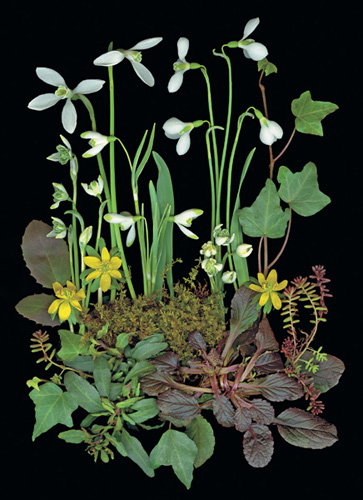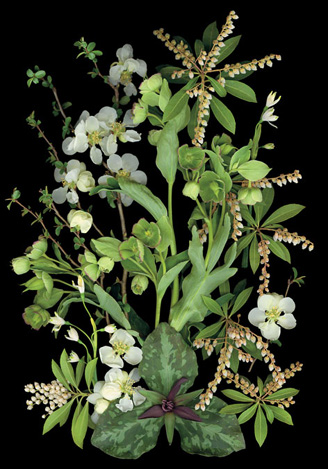
In late winter, Galanthus (snow drops) varieties hint of spring: A G. ‘Atkinsii’; B G. elwesii; C G. nivalis ‘Lady Elphinstone’; D Eranthis hyemalis; E Sedum album ‘Coral Carpet’; F Ajuga reptans ‘Bronze Beauty’; G Hedera helix ‘Blue Moon’; H Mahonia repens; I G. ‘Ophelia’; J G. ‘Sherlock’.

Although they often bloom in winter, as early as January, snowdrops are often thought of as the first flowers of spring. To most of us gardeners, the snowdrop is Galanthus nivalis, a slow-spreading bulb with strappy green leaves and nodding white flowers. A few years ago, I was given a clump of G. elwesii. That species has gray-green leaves, the color of leeks, and is not shy in increasing numbers.
To my surprise, a cult of snowdrops has arisen in England. Collectors wriggle on their bellies to examine the minute variations in flowers. Galanthophiles “ooh” and “ah” over slight variations in the blossoms: a spot of green at the tips, or no green at all, stripes, double flowers, cream-colored ones, or even yellow blooms. At Greenwood Gardens in Short Hills, New Jersey, they were planted behind a chest-high retaining wall to view without back or belly injury.
There are 19 species and some 1,500 varieties of this little flower. On January 31, 2011, one bulb of Galanthus plicatus (folded or pleated petals) ‘E.A. Bowles’, named for the gardener who discovered it, sold on eBay for £357. Variations may turn up anywhere, so keep your eye out for them.
While down on your stomach, catch the winter aconites, Eranthis hyemalis—buttercup cousins that open on sunny winter days, even in snow. They can survive subzero temperatures and bloom at below 32 degrees F. Proteins and sugars in the cells may thwart the damage from freezing.
The flowers we probably know best for blooming in winter are hellebores. Helleborus niger is the first to bloom. Called the Christmas rose, the plants rarely flower in December, but certainly do later. More common are the so-called Oriental hybrids— H. orientalis or H. x hybridus. These plants bear white to pale pink long-lasting sepals that ripen green. Competition has lowered prices and initiated a race to breed ever-more intricate hybrids with double or frilly sepals, and colors including apricot pink, daffodil yellow, and slate gray.
Though considered evergreen, one-year-old leaves should be cut off before new growth begins in winter. Be very careful not to damage flower buds or emerging new leaves.
Late winter in USDA Zone 8 is highlighted by flowers, clockwise from bottom center: Trillium decumbens; single white Chaenomeles x superba ‘Jet Trails’; Japanese Andromeda Pieris japonica with lily-of-the-valley-like–flowers; white Leucojum vernum; green flowers of Helleborus foetidus.
